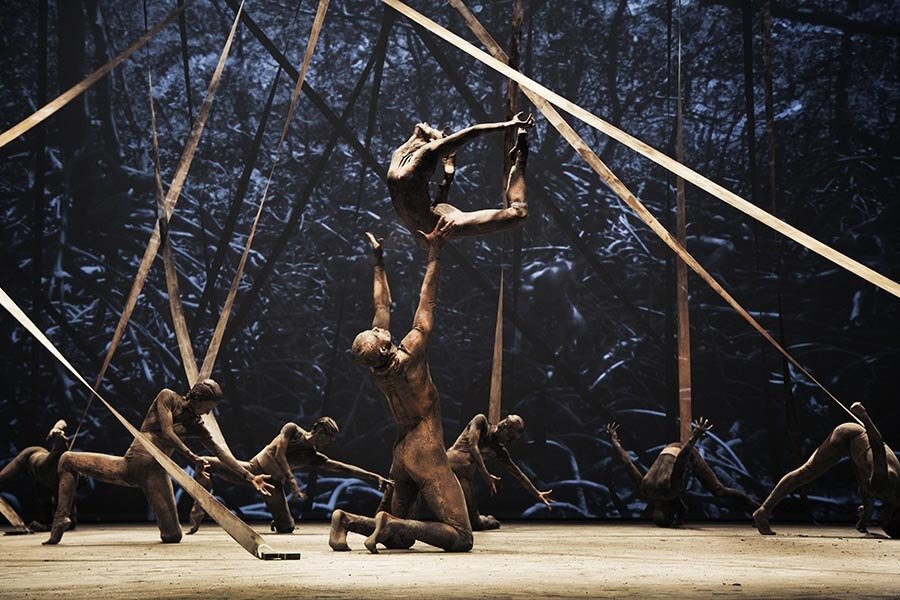Dance review: Dog Without Feathers' brutally poetic imagery speaks to a world near collapse
Mud-caked creatures inhabit a bleak universe in Deborah Colker’s monumental mix of film and dance
Dancers pull bands that echo the imagery of mangrove roots, in Dog Without Feathers. Photo by CAFI
Dog Without Feathers streams via DanceHouse until October 11.
BODIES SCRAPE THEIR stomachs across a cracked dry riverbed on a big screen, while dancers caked in grey mud fold their torsos and bend their arms to mimic the fissures in the parched earth.
In another scene in Brazilian choreographer Deborah Colker’s epic and unsettling Dog Without Feathers, dancers pull around beige bungee-ribbons fastened to their waists—echoing the tangles of mangrove roots projected onscreen.
The multimedia production, now streaming as part of DanceHouse’s Digidance series, melds black-and-white film and live choreography in wildly innovative ways. The troupe and cinematographer Cláudio Assis travelled to Brazil’s Capibaribe River region to capture footage that then triggers, reflects, and loops in and out of the sculptural patterns we see onstage.
For dance fans, Colker’s work is a thrill—gushing with raw energy, big ideas, and brutal yet poetic imagery. The soundtrack mixes spare, raw text with an electroscore that’s often driven by Brazilian percussion.
Dog Without Feathers is inspired by a harsh place—a fact that’s fleshed out in the documentary that helpfully precedes the streamed performance in this presentation. Capibaribe is a region where people rely on a river that’s ravaged by pollution, industrialization, and global warming—the poetic voiceover describes the sluggish waterway as flowing like “a sort of thick liquid”. Onstage, stark wooden crates reference the region’s integral crab fishery.
Some of the imagery we see onscreen is indelible: one scene features a pair of clay-caked dancers slowly dragging a dugout boat across a bone-dry riverbed.
Centring the show are Colker’s committed performers as loin-clothed, primal creatures who seem half-animal, leaving puffs of dust as they move.
Sometimes they lunge and squat, like reptiles or insects; in other moments they stamp their feet on the ground, claiming the earth they seem to have emerged from. In one solo, en pointe, a woman poses and darts like a mud-covered bird. Frequently, human resilience bursts through in hyperenergized, capoiera-inflected sequences where bodies jump, kick, and roll through the air. Most of the movement is earthbound, with splayed feet and bent appendages, but the honed, balletic technique is obvious.
To Colker’s credit, the work is never literal, and never lecturing. Instead, by transporting us to an otherworldly, bleakly surreal place, she can speak even more directly to the here and now.
It’s not always an easy journey. The world is harsh and unrelenting, and the piece is long at 90 minutes. Sometimes the score feels monotonous, and lacks the weight and complexity of the imagery.
But it's also a work that feels monumental--as both a daring creative achievement and as a statement about poverty, environmental collapse, and deeply human struggle. There are images that will stick with you like that mud clings to the dancers' skin.













